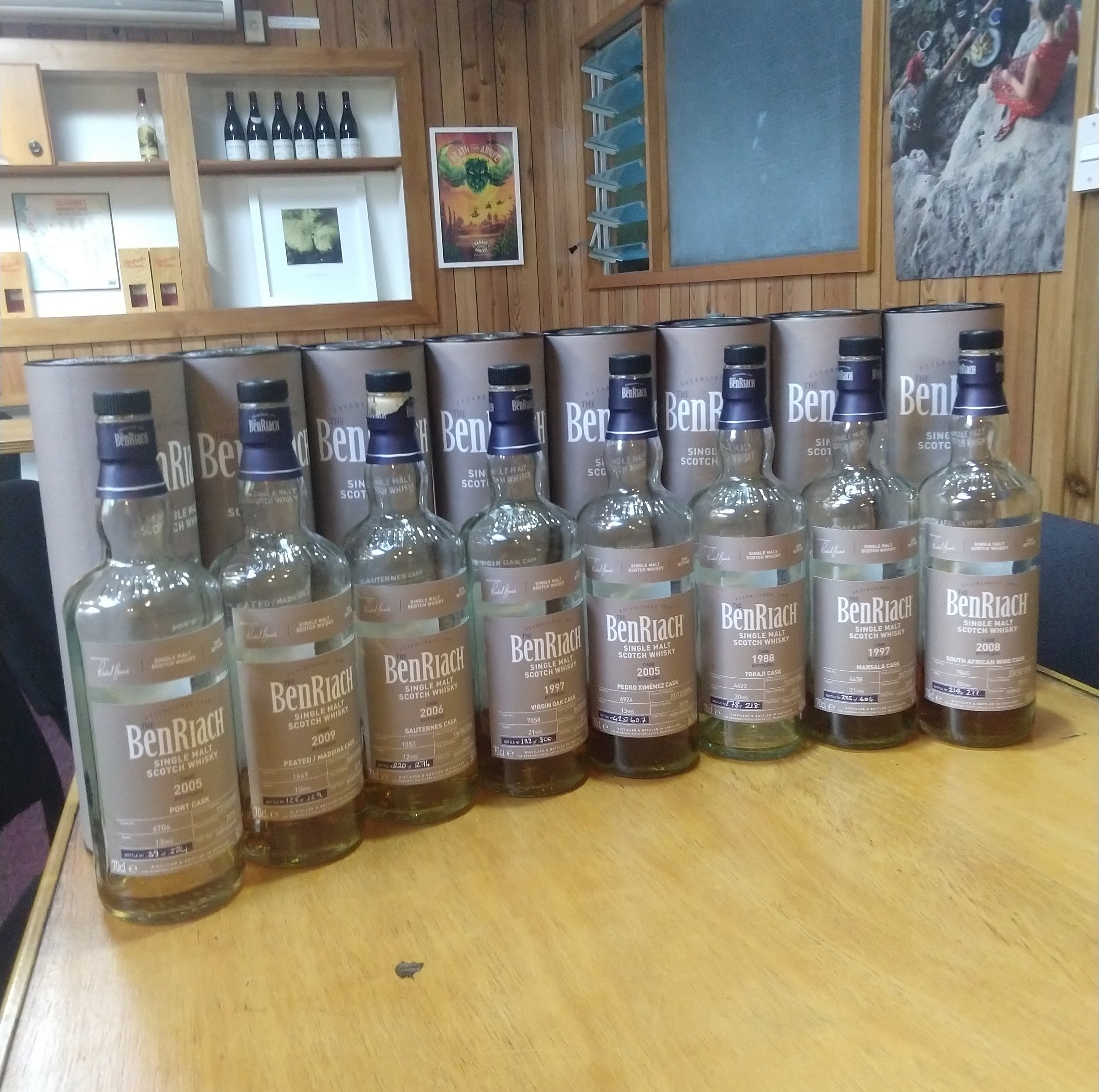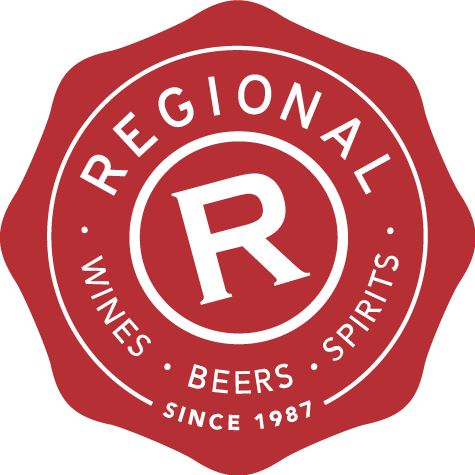
The BenRiach wine cask degustation at Regional Wines
So we’ve done crazy casks before and we’ve also done wine casks, and, well hell, we’ve certainly done single casks and verticals from a single distillery... but this was the first time (that I know of), that Regional had lined up a single cask vertical with quite such an eclectic array of wine cask maturation. Port, Masala, Madeira, PX, South African wine, Tokaji and Sauternes were all present and correct in BenRiach’s Batch 16 release and lined up as follows...
- Benriach 1997 21yo Cask #7858 Batch 16 Virgin Oak hogshead (Mystery whisky)
- Benriach 2008 10yo Cask #7865 Batch 16 South African wine barrique 59%
- Benriach 2009 10yo Cask #1647 Batch 16 Madeira hogshead – 59%
- Benriach 2005 13yo Cask #6704 Batch 16 Port Cask hogshead – 57.5%
- Benriach 1997 21yo Cask #4438 Batch 16 Marsala Cask hogshead – 54.1%
- Benriach 2006 12yo Batch 16 Cask #1853 Sauternes barrique – 55.2%
- Benriach 1988 30yo Cask #4422 Batch 16 Tokaji Wine Cask hogshead– 46.5%
- Benriach 2005 13yo Cask #6924 Batch 16 Pedro Ximénez butt – 56.2%
It’s so nice to come away from these tastings feeling like you’ve learned something. Gleaned a nugget of “truth” about the way the rather opaque whisky industry actually works and how the fruits of its labours actually taste. Hopefully then, the next time a 30 yo Tokaji cask pops up for sale, you might be ready to pounce.
In this vein - there were a few important questions leading us into this tasting.
With a notion that the cask can supposedly contribute up to 80% of a whisky’s final flavour - would this lineup offer a myriad of distinctive flavours?
Alternatively, would the ever elusive notion of distillery style mean that all these whiskies might actually, sort of, taste the same? Or could both outcomes be true - a distinct house style with layers of wine dressing scattered on top?
These questions could possibly be answered in a dash if the inter-relationship of wood and alcohol was an exact science - but unfortunately it just isn’t. The role that the previous contents of the cask plays is obviously important, but varies depending on both the nature of the cask and the nature of the original contents. The original contents alter the wood for sure. Studies have shown that neither new European oak or the addition of straight sherry to whisky produce the same flavours as ageing in an actual European oak sherry cask. However, the previous cask contents will also strip some of the elements that contribute flavour. Think of an old solera cask that has sat in a bodega for 100 years and is now essentially inert, or an American oak bourbon barrel that has aged bourbon spirit for 10 years resulting in deep extraction of colour and flavour.
On the flip side, some of this original liquid will certainly permeate its way into the wood (the amount being affected by char and wood grain) to be leached out into the whisky at a later date. But this is almost impossible to quantify, and the guesses of how many litres this may present remain guesses at best.
Of course the notion of what was previously in the cask is also just one piece in the jigsaw that is whisky production. The provenance of the oak (US or European), how long the spirit is aged in the cask and the size of the cask are factors that many would argue are more important, or at least as integrally important. To complex things further, there is very little disclosure of just how much time the previous contents has spent in the cask before it was then filled with whisky. If a cask has only contained a red wine for 6 months, will it have had a chance to effect the oak or be absorbed into the oak? If not, then you’ll simply be tasting oak, either European or American?
Which finally leads us to ponder whether it’s more prudent to question what these whiskies actually have in common - as opposed to focusing on the one element that separates them (the previous cask contents) and of course the answer is heaps. 5 are aged in hogsheads, 5 of them are 13 years old or under, 5 or 6 of them are most probably European oak, and, of course, they are all distilled at BenRiach. In addition, the wine aspect actually unites them too, 5 of the wine styles being sweet fortified. With so much in common it’s easy to see why so many people found them less divergent than they had expected.
That said, as we almost always see, the room was fairly divided on the subject of just how different these whiskies were, and plenty did find them contrasting, and if the guesswork was anything to go by - the whiskies were certainly different enough to spot which was which. But then, the Madeira cask was the only peated whisky present, the 30 year old Tokaji was very evidently old and low in alcohol, and the mystery was aged in virgin oak and tasted very bourbon-like. That’s three from eight which should stand out like cropped dog’s ears (I think that’s the expression?).
So, as ever, more questions than answers really - but this is the beauty of whisky - its beguiling nature to leave us gobsmacked and wondering - just how this amazing elixir of life came to taste how it did...
Here’s some tasting notes and scores.
Benriach 1997 21yo Cask #7858 Batch 16 Virgin Oak hogshead (Mystery whisky) - Score 8.2
Bourbon all the way for me this one - so presumably US oak... but not necessarily. Caramel, vanilla and coconut with some complexing tobacco and boot polish. Pretty clean and classy with some Longmornesque fruit... but hot hot hot, even after 21 years.
Benriach 2008 10yo Cask #7865 Batch 16 South African wine barrique 59% - Score 7.71
Sweet and sour, Jeckyl and Hyde...a very schizoid whisky this one. One moment there’s dried and fresh fruits (apricots and sultanas) at the fore, next minute an almost medicinal savoury element kicks in. Good fun and plenty going on to keep the mind and palate absorbed.
Benriach 2009 10yo Cask #1647 Batch 16 Madeira hogshead – 59% - Score 8.36
Cheese toastie with mature cheddar and smoked ham anyone? Some sweetness (possibly from the Madeira) balances the savoury smoky elements but ultimately the alcohol isn’t integrated and the balance not quite there.
Benriach 2005 13yo Cask #6704 Batch 16 Port Cask hogshead – 57.5% - Score 7.34
A sweet cup of tannic tea served alongside a bowl of chicken noodle soup (as you do). Some pleasant chocolate and raisin notes that I’ve come across in other port cask whiskies before (like the Portonova at Best of the Best ‘19) but quite dirty, sulphurous and heavy handed. Perfect for those with a jaded palate, but judging by the scores - not everyone's cup of tea.
Benriach 1997 21yo Cask #4438 Batch 16 Marsala Cask hogshead – 54.1% - Score 7.57
A maraschino cherry picked from old fashioned made with a touch too much bitters. Similar to the port cask but without the sweetness to balance it out.
Benriach 2006 12yo Batch 16 Cask #1853 Sauternes barrique – 55.2% - Score 8.14
Lemon meringue, pears and apricots - wow, this could be a tasting note for a glass of Sauternes, dare I say it. Stone fruits and custard on the finish, almost like a sherry cask.
Benriach 1988 30yo Cask #4422 Batch 16 Tokaji Wine Cask hogshead – 46.5% - Score 7.68
This was like being transported 18 years into the future and re-tasting theSauternes cask. Many flavors in common but the citrus and stone fruit has mostly receded and been replaced by some dusty green figs, savouriness and menthol elements. Has this aged too far and got away on itself - possibly. Was outgunned by its peers - was really one for a standard strength lineup in hindsight.
Benriach 2005 13yo Cask #6924 Batch 16 Pedro Ximénez butt – 56.2% - Score 8.84
Well this one really was everyone’s cup of tea - our winner on the night. A luscious, leathery, stewed fruits number this one, that really did seem to scream PX.
Please email John at online@regionalwines.co.nz if you are keen on purchasing some of these whiskies.
